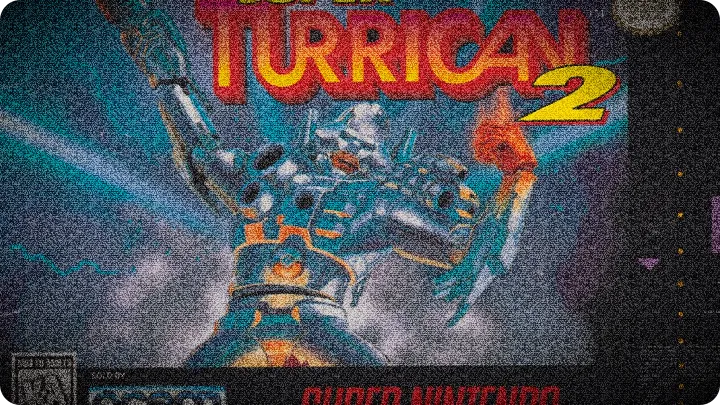Fun fact before the first laser volley: the Turrican series grew out of German developer Factor 5’s early Amiga work. Their collaborations with composer Chris Huelsbeck turned the games into audio-visual showcases. By 1995, Factor 5 had a reputation for squeezing crisp sound and impressive graphics out of limited hardware. That’s exactly what you notice when you boot up Super Turrican 2 on the SNES.
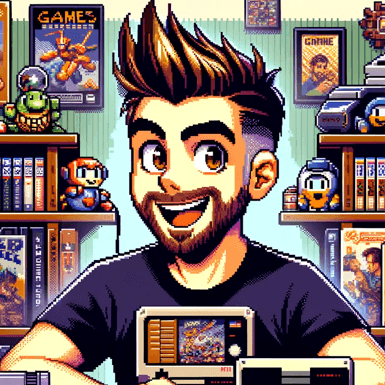 Okay, I’ve got the SNES pad snug in my hands and the CRT glow is doing its thing. Level one opens with that punchy synth — Huelsbeck’s fingerprints, unmistakable. The first thing that sticks is how tight the basic run-and-gun feels: jumps land where you expect, and the spread-shot cleans out groups without feeling overpowered.
Okay, I’ve got the SNES pad snug in my hands and the CRT glow is doing its thing. Level one opens with that punchy synth — Huelsbeck’s fingerprints, unmistakable. The first thing that sticks is how tight the basic run-and-gun feels: jumps land where you expect, and the spread-shot cleans out groups without feeling overpowered.
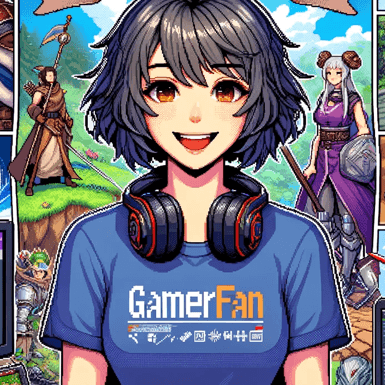 I noticed the new toys straight away. The flamethrower is a nice addition for close quarters and those tight caverns, and the rope mechanic changes the pace — you can cling, swing, and snag those hard-to-reach power-ups. It’s a good balance between arcade immediacy and the platforming nuance we loved in past entries.
I noticed the new toys straight away. The flamethrower is a nice addition for close quarters and those tight caverns, and the rope mechanic changes the pace — you can cling, swing, and snag those hard-to-reach power-ups. It’s a good balance between arcade immediacy and the platforming nuance we loved in past entries.
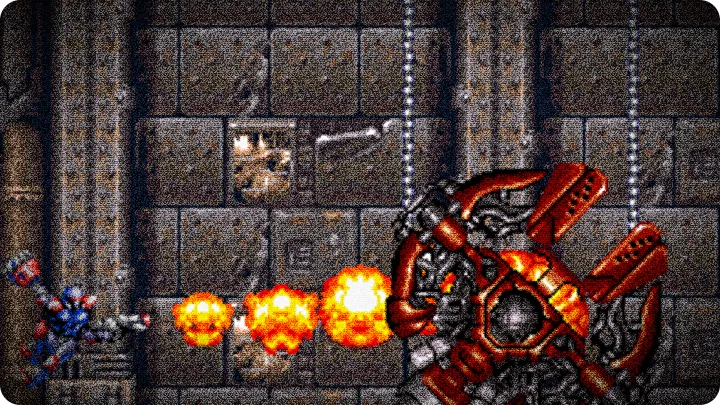
 That balance is the heart of the experience. There are sections that feel like classic side-scrolling shooters — you pick up homing missiles and the screen floods with enemies — and then there are straight platforming runs where timing and rope use matter more than raw firepower. I’m enjoying the variety.
That balance is the heart of the experience. There are sections that feel like classic side-scrolling shooters — you pick up homing missiles and the screen floods with enemies — and then there are straight platforming runs where timing and rope use matter more than raw firepower. I’m enjoying the variety.
 Variety, yes, but I have to be frank: almost half the levels are more linear than previous Turrican games. If you came here expecting those sprawling secret mazes the series once made its hallmark, you’ll feel the difference. Still, Factor 5 compensates with tighter pacing and some spectacular set pieces.
Variety, yes, but I have to be frank: almost half the levels are more linear than previous Turrican games. If you came here expecting those sprawling secret mazes the series once made its hallmark, you’ll feel the difference. Still, Factor 5 compensates with tighter pacing and some spectacular set pieces.
 Speaking of set pieces — there’s a mid-game factory stage where conveyor belts, crushers, and airborne turrets combine and force you into quick weapon swaps. That is where the rebound shot shines. Bounce it off walls to hit turrets tucked behind columns. I got caught once trying to barrel through with the laser — not recommended.
Speaking of set pieces — there’s a mid-game factory stage where conveyor belts, crushers, and airborne turrets combine and force you into quick weapon swaps. That is where the rebound shot shines. Bounce it off walls to hit turrets tucked behind columns. I got caught once trying to barrel through with the laser — not recommended.
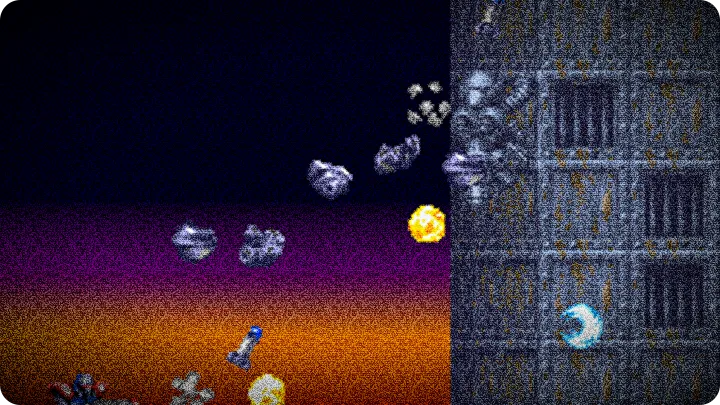
 Hot tips time, then. We’ll go through them while we play:
Hot tips time, then. We’ll go through them while we play:
- Use the rope to reach hidden crates and to pause in mid-air — it’s also great for avoiding projectile-heavy corridors.
- Wheel-mode is your get-out-of-jam card: brief invincibility, mines and rockets let you clear chokepoints. Don’t waste it on trivial encounters — save it for boss openings or overwhelming waves.
- Flamethrower eats close-range swarms; switch to homing missiles for aerial clusters.
- Conserve your special secondary shots; some bosses reveal weak spots only after a phase change, and you’ll want homing missiles ready.
 We just hit one of those memorable moments — a cavern that collapses behind us while a turret-lined bridge rises ahead. I had a split second to decide: rope across and flamethrower the last turret, or switch to spread and sprint. I grabbed the rope and barely made it; the music helps sell the tension. It’s one of those sequences that feels made-for-CRT dramatic lighting.
We just hit one of those memorable moments — a cavern that collapses behind us while a turret-lined bridge rises ahead. I had a split second to decide: rope across and flamethrower the last turret, or switch to spread and sprint. I grabbed the rope and barely made it; the music helps sell the tension. It’s one of those sequences that feels made-for-CRT dramatic lighting.
 The bosses deserve their own mention: mostly large, mechanical, and multi-phased. The halfway boss with the segmented armor really made me learn the rebound timing — you have to hit the exposed nodes when they flash, then back off to avoid the plasma sweep. It’s challenging but fair, and the patterns are memorable rather than cheap.
The bosses deserve their own mention: mostly large, mechanical, and multi-phased. The halfway boss with the segmented armor really made me learn the rebound timing — you have to hit the exposed nodes when they flash, then back off to avoid the plasma sweep. It’s challenging but fair, and the patterns are memorable rather than cheap.
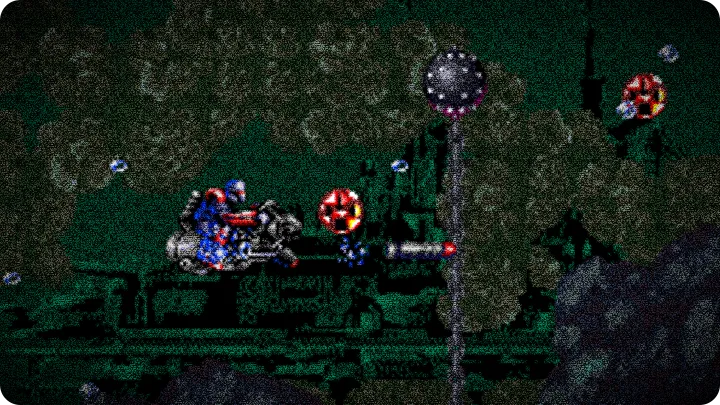
 And the final boss? That one is a proper piece of work. A hulking Machine core with rotating armatures, missile pods that spawn minions, and a vulnerability that opens only after you sever auxiliary reactors. It’s the kind of climax where you use nearly every tool the game taught you: rope to reposition, wheel-mode to survive a burst of homing rockets, flamethrower to clear spawned drones, then a steady barrage of homing missiles on the exposed core. Took us a few tries, but the payoff — the visuals, the orchestral synth swell, the last explosion on the CRT — made it worth it. Classic 1990s gaming theater.
And the final boss? That one is a proper piece of work. A hulking Machine core with rotating armatures, missile pods that spawn minions, and a vulnerability that opens only after you sever auxiliary reactors. It’s the kind of climax where you use nearly every tool the game taught you: rope to reposition, wheel-mode to survive a burst of homing rockets, flamethrower to clear spawned drones, then a steady barrage of homing missiles on the exposed core. Took us a few tries, but the payoff — the visuals, the orchestral synth swell, the last explosion on the CRT — made it worth it. Classic 1990s gaming theater.
 Now for what holds it back. The move toward linear levels trims exploration, and some set pieces feel recycled across stages. Also, a few enemy placements lean toward cheap hits if you’re not memorizing layouts. The difficulty curve is uneven: some parts are blissfully arcade-smooth, others spike in a way that slows progression and tempts you to grind for continues.
Now for what holds it back. The move toward linear levels trims exploration, and some set pieces feel recycled across stages. Also, a few enemy placements lean toward cheap hits if you’re not memorizing layouts. The difficulty curve is uneven: some parts are blissfully arcade-smooth, others spike in a way that slows progression and tempts you to grind for continues.
 I’ll add that the inventory of weapons is excellent, but button mapping on the SNES pad occasionally forces awkward swaps mid-jump. You learn to compensate, but on a few tight jumps I wanted a faster weapon-change mechanic. Still, when everything clicks — music, controls, weapon choice — Super Turrican 2 shows why Factor 5 earned its reputation.
I’ll add that the inventory of weapons is excellent, but button mapping on the SNES pad occasionally forces awkward swaps mid-jump. You learn to compensate, but on a few tight jumps I wanted a faster weapon-change mechanic. Still, when everything clicks — music, controls, weapon choice — Super Turrican 2 shows why Factor 5 earned its reputation.
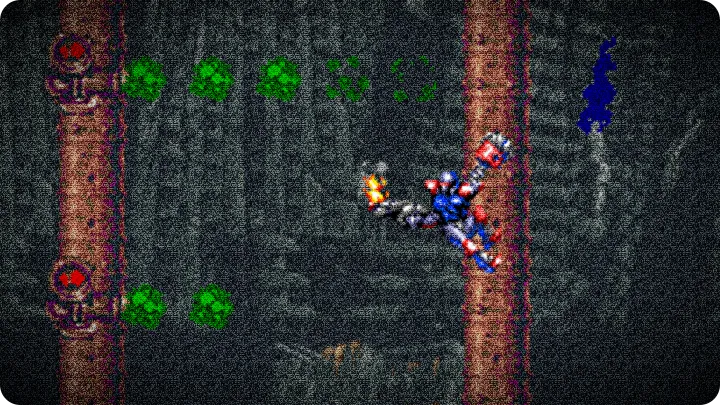
 Grade-wise, we’d call this a B. It excels in presentation, controls, and memorable boss design, but the pared-back level exploration and occasional difficulty quirks keep it from being truly exceptional.
Grade-wise, we’d call this a B. It excels in presentation, controls, and memorable boss design, but the pared-back level exploration and occasional difficulty quirks keep it from being truly exceptional.
 Agreed. For fans of brisk, well-crafted action with a few rough edges, it’s a strong play. For completionists chasing secrets in the old Turrican way, know that this installment tightens the focus. Either way, it’s an engaging cartridge that makes the SNES hum — and that final boss is worth the endurance if you like dramatic finales.
Agreed. For fans of brisk, well-crafted action with a few rough edges, it’s a strong play. For completionists chasing secrets in the old Turrican way, know that this installment tightens the focus. Either way, it’s an engaging cartridge that makes the SNES hum — and that final boss is worth the endurance if you like dramatic finales.
more info and data about Super Turrican 2 provided by mobyGames.com

